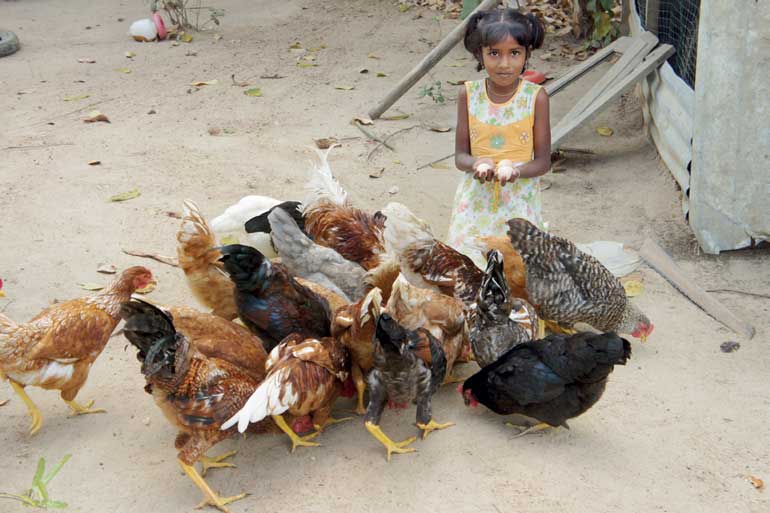Friday Dec 13, 2024
Friday Dec 13, 2024
Thursday, 15 September 2016 00:00 - - {{hitsCtrl.values.hits}}
 If we didn’t know how many chickens we could produce or how many eggs they could lay, our food value chains would begin to fall apart
If we didn’t know how many chickens we could produce or how many eggs they could lay, our food value chains would begin to fall apart
By Kundhavi Kadiresan
Like many, I remember the warnings of parents and teachers to never count your chickens before they’ve hatched, and to never keep all your eggs in one basket.
But moving beyond the clichés have you ever stopped to wonder just how many chickens there are in Asia or the world? And how many eggs must hens lay each day to feed us all? These light-hearted questions in fact carry a serious message. If we didn’t know how many chickens we could produce or how many eggs they could lay, our food value chains would begin to fall apart. The same important facts must be known for all food produced. Supply must meet demand.
We know counting is important for a myriad of reasons. We count the number of people on the planet and we mathematically project a rise in population – by 2050 the world’s population is expected to grow by another two-billion topping out at more than nine billion – and we rightly worry about whether we will be able to produce enough food to feed everyone by then.
So ensuring that we can accurately count our chickens or our sheep, while correctly predicting our supplies of rice, fruits, vegetables and crops, are critical. Unfortunately, we don’t always get the count right and some countries are better than others when it comes to collecting agricultural statistics. That’s why it’s time to work together to improve the way we gather these statistics worldwide.
The UN’s Food and Agriculture Organization (FAO), is working with our member countries and partners to improve these agricultural counts. Since 1950, FAO has been a leader in agricultural censuses by providing technical guidance to countries that conduct their national censuses every ten years. More recently, our member countries have asked us to find ways to improve the methods of gathering statistics and to provide guidance on sustainable production, livestock, forestry, fisheries and how to analyse impacts from climate change.
To implement better practices on statistical gathering, and to share best practices on agricultural and rural statistics between countries, FAO and our partners are supporting two major initiatives. One is called the Global Strategy to Improve Agricultural and Rural Statistics and the other is the World Programme for the Census of Agriculture 2020 (WCA 2020).
The Global Strategy provides the vision for national and international statistical systems to meet 21st century challenges, including poverty, food insecurity, global warming and the sustainable use of land and water resources. The WCA 2020 is providing governments with a new approach to comprehensive data collection on the structure of agriculture and it facilitates international comparisons. A new global census round is getting underway this year and, for the first time; it will include aquaculture as well as capture fisheries.
In order for national policy makers to intervene in agricultural production, at the right time and in the right place, they need reliable statistics. The data provided by these national censuses will form the foundation for building better systems that collect more recent and periodic information. For the first time, this new round of censuses will look at the impacts that greenhouse gas and ammonia emissions are having on agricultural activities.
This month professional statisticians and census leaders, who are likely to play a role in the planning and execution of the next agricultural census in their respective countries, are meeting in Bangkok to discuss WCA 2020. A total of 21 countries from Asia are participating, including Sri Lanka.
But all this attention is about more than just numbers and ways to count. As mentioned, statistics are the foundation of world agriculture. They underpin all agricultural decisions and work, and provide valuable information to meet challenges such as food insecurity, poverty and climate change.
Let’s not forget that agriculture provides the primary source of food for humans, feed for animals, fibres for clothes, and material for fuel and housing – all things needed by a growing world population.
As we work together and with others to meet the world’s Sustainable Development Goals by 2030, the WCA 2020, implemented during 2016-25, has the potential to help provide valuable data to ensure many SDG targets will have been accurately met. We need to be sure that when shepherds bless and count their sheep they will have arrived at an accurate tally. To feed the world of our children and their children, we shouldn’t count our chickens before they hatch.
[The writer is Assistant Director-General and Regional Representative for Asia and the Pacific, Food and Agriculture Organization of the United Nations (FAO).]